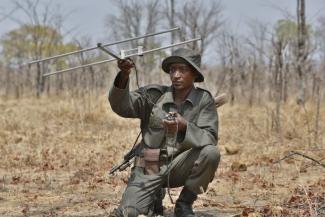Nature conservation
Cross-border wildlife protection

Southern Africa has a unique network of natural habitats and protected areas. This world region is home to an essential share of global biodiversity and hosts a great variety of wildlife. Game animals, moreover, attract tourists. Numerous animal and plant species have benefited from intensive conservation efforts in the past. For example, the Kavango-Zambezi Transfrontier Conservation Area (KAZA) covers more than 400,000 square kilometres in five countries in Southern Africa and is home to approximately 250,000 African elephants.
In total, the Southern African Development Community (SADC) has designated 18 Transfrontier Conservation Areas (TFCAs). They play a pivotal role in safeguarding some of the continent’s largest remaining wildlife populations. They provide livelihoods to many rural communities in and near the parks and foster regional integration. More than 270 million people live in SADC countries, and the majority of them depend on natural resources such as clean water, fuel wood, construction materials and food, including bush meat.
The parks generate income and employment. About every 15th job in sub-Saharan Africa is directly or indirectly linked to tourism. Accordingly, wildlife-related tourism is an important pillar of regional development. However, it is increasingly being undermined by illegal harvesting and trade of wildlife products. Poaching syndicates that are involved in the illegal trade of ivory, rhino horn and other wildlife resources are playing an especially destructive role.
In 2015, more than 1,300 rhinos and 20,000 elephants were poached in Africa. The SADC region was hit especially hard. KAZA and Tanzania’s famous Serengeti National Park were affected for example. Some countries, including Mozambique and Malawi, moreover, have been identified as important transit countries for illegal wildlife commodities.
The current crisis is being fuelled by a growing demand for wildlife products, predominantly in Asian countries such as China and Vietnam. Within the SADC region, poaching and trafficking are related to weak governance, insufficient law enforcement and corruption. In view of high profit margins, transnational organised crime is increasingly involved. High rates of rural poverty and unemployment ensure there is a constant supply of poachers who are willing to risk their lives.
The rise in cross-border poaching and smuggling has serious implications in the affected countries. Not only is the conservation of some critically endangered species at stake – so are the livelihoods and security of local people in the SADC region.
One giant LEAP
In response to the dramatic, border-defying trend, the environment ministers of the SADC member states agreed in 2013 to cooperate on tackling wildlife crime. They requested the SADC Secretariat in Gaborone, Botswana, to draft a five-year regional law enforcement and anti-poaching (LEAP) strategy in cooperation with all member states. In addition, the ministers agreed to establish a regional anti-poaching coordination unit at the Secretariat as well as to produce materials for education and awareness raising.
Accordingly, the SADC Secretariat started a comprehensive participatory process to draft the LEAP strategy with support from GIZ (see box), and the Worldwide Fund for Nature (WWF). The approach tackles the entire illegal trade chain and emphasises five priorities:
- improving field protection,
- minimising the illegal wildlife trade,
- strengthening and harmonising legislation and judicial procedures,
- enhancing community involvement in natural resource management and
- promoting the sustainable use and trade of natural resources.
In November 2015, the member countries’ ministers of environment and natural resources adopted the LEAP strategy for the years 2016 to 2021. In line with the strategy, the five KAZA member countries – Angola, Botswana, Namibia, Zambia and Zimbabwe – are now taking a joint approach to tangible action. For instance, they are implementing joint anti-poaching operation guidelines and rules for cross-border cooperation. In the past, KAZA TFCA ranger patrols had to stop pursuing poachers once criminals crossed a national border. Valuable time was lost while the rangers informed their colleagues in the neighbouring countries, and the poachers would normally have disappeared by the time they arrived. The new guidelines are designed to facilitate better coordination and allow rangers to follow poachers across borders. Better intelligence sharing is meant to help authorities detect poaching activities, foresee patterns, plan proactive enforcement and warn partner agencies in partner countries in a timely manner. Moreover, it is becoming easier to collect and share evidence in order to prosecute organised crime.
The LEAP strategy, moreover, defines the role and responsibilities of the SADC Secretariat’s new Wildlife Crime Prevention and Coordination Unit (WCPC). Goals include to:
- enforce the law more effectively,
- minimise wildlife crime and illegal trade,
- involve people in nature conservation and development efforts,
- ensure sustainable use and trade of natural resources and
- improve the protection of wildlife in the parks.
The member countries must now implement the strategy. The SADC Secretariat is playing a role of leadership, cooperation, coordination, networking and convening. The implementation plan covers finance and resource mobilisation, capacity development, technology development and transfer, communication, advocacy and awareness. The strategy itself brings consistency and unity of purpose among the member states, which are already implementing parts of the strategy using their own often limited resources. Furthermore, the strategy also serves as a tool for mobilising additional resources towards combating wildlife crime. To this end, all SADC member states are actively encouraged to participate in the process of implementing the LEAP strategy on the regional, national and local level, since only a joint effort, built on cooperation and mutual trust, can reduce the threats of poaching and wildlife smuggling in Southern Africa.
Moses Chakanga is a technical adviser for natural resources management in the SADC/GIZ project Transboundary Use and Protection of Natural Resources (TUPNR) in Gaborone, Botswana.
Flora Müller is a GIZ technical adviser for the German Polifund Project to Combat Poaching and Illegal Wildlife Trade in Africa and Asia.
flora.mueller@giz.de
Klemens Riha is the GIZ coordinator for the German Polifund Project to Combat Poaching and Illegal Wildlife Trade in Africa and Asia.












